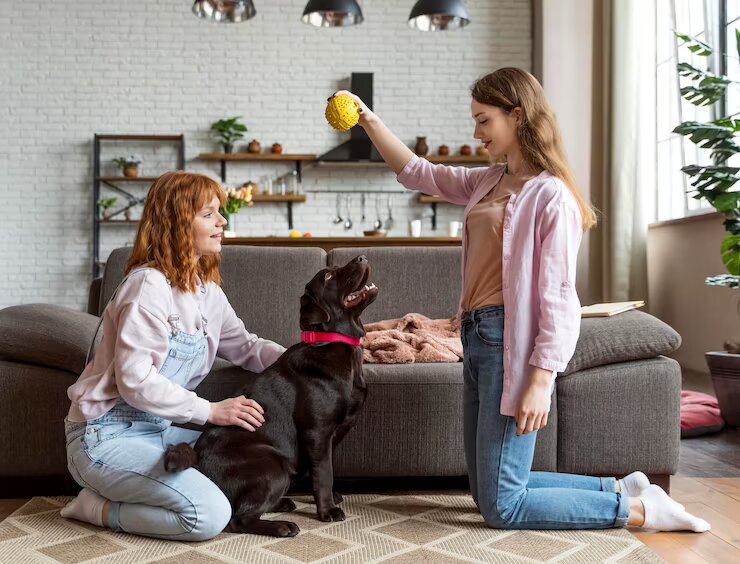Understanding And Managing Your Pet’s Behavioral Needs



Pet owners know that being able to understand and manage their pet’s behavior is beneficial. When it seems like your pet doesn’t listen, keying into a particular behavior may be the answer to understanding why. Likewise, if you want to enjoy your pet more, there are steps you can take to improve your pet’s behavior.
It’s essential to supply our pets with adequate exercise, good nutrition, and lots of love. Some behaviors are instinctive, so training and monitoring them can go a long way to ensure your pet adapts to your environment and proceeds to live a long and happy life. Here are some ways you can more easily understand and manage the behavior of your pet.
Diagnosing The “Why” For Bad Behavior
The “why” of why your pet behaves badly is crucial for pet owners to understand. There’s usually a reason behind poor attitude, and it may be something as simple as your pet feeling neglected and wanting attention.
Evaluating what is going on with your pet is the first step you need to take as a responsible pet owner. Look at your pet’s environment and ask yourself questions, such as the following:
- Does my pet feel threatened?
- Is my pet uncomfortable?
- Does my dog have car anxiety?
- What is happening around my pet when it acts this way?
Ask and figure out the where, when, why, and how so you understand what is causing the behavior. Then you can work to prevent triggers and intervene quickly when you notice a change for safety.
Reading Your Pet’s Body Language


Pets cannot communicate with speech; rather, they utilize their body language to tell us when something is making them feel a specific way. Taking note of your pet’s body language can clue you in whether it is feeling anxious, scared, content, or sad.
Here are some clues to help you tune into your pet’s body language:
- Anxious – most pets display feeling anxiety through lots of nervous habits, including lip licking, pacing, frequent shaking, or panting.
- Scared or Threatened – pets show a lot of tension when they feel threatened. You often may notice their ears lay flat back, their tail is tucked, they are stiff or hair is sticking up on the back of the neck or near the tail. This feeling may often have your pet react with aggression, so your pet may hiss, growl, or even attempt to bite.
- Alert – pets feel alert when you notice their ears straight up or perked forward, their head tilted to the side as if they hear something, and their tail up and straight.
- Content – a happy and relaxed pet often has a loose body and submissive behavior such as laying on its back or side. They often will nuzzle or look for affection and appreciate lots of pets, responding with licks.
Managing Certain Pet Behaviors
Now that you have some background and can understand and recognize your pet’s behavior, you can more effectively work to correct it. Prevention can often help ensure that your pet doesn’t behave badly, but if you note it is happening, there are some steps you can take.
Aggressiveness
Aggressive behavior in your pet is usually caused by feeling threatened or being in pain. If a pet is afraid of something touching a part of its body, it might retreat or act out.
If you suspect your pet suffers from pain, you should contact your veterinarian for an examination. For example, if your dog keeps throwing up, acts aggressively when touched, or doesn’t want to eat, this is a telltale sign that something is wrong, and you need to call the vet.
Threatened pets often react with aggression too, so consider if something makes them feel this way. For example, are they eating and acting out when someone comes near? Could they be overstimulated from too much rough play and need a space to relax?
Vet techs at Bond Vet’s Arlington, DC animal hospital share, “Take time to evaluate the situation, and determine what you can do to help your pet feel safer and more secure”. Some steps may include giving your pet its own area (not a crate) within the home and having the pet eat without anyone bothering it.
Separation Anxiety
Pets often feel anxious when they are left alone, feeling separated and abandoned. If you notice when you leave the house your pet resorts to destructive behavior like tearing up floors and furniture, this is a sure sign that they are suffering from separation anxiety.
Pacing, panting and lots of licking also indicate your pet is feeling anxious. Have you noticed your pet soils or urinates in the house when you leave? Give your pet proper house training, and seclude your pet if you need to leave the home to limit destructive behavior. You might also consider getting a pet sitter to come to your home and keep the animal company if your pet has trouble being separated.
Activities And Distractions
Your pet may simply need to be stimulated often to control its behavior. Provide your pet with activities to stimulate its senses and provide an outlet for energy. Keep an eye on your dog’s appetite to understand its activity level and distractions. Cats enjoy scratching posts so they don’t ruin furniture, and dogs can spend a lot of time working on a chew toy, food puzzle, or large bone.
Exercise is another great way to expand your pet’s energy. Ensure you’re taking your pet for a lot of walks, and runs, engaging in playtime, or even getting some outside training. Rest is a priority too, so your pet needs a comfortable place to relax with a blanket, bed, or other comfort items nearby.
Positive Reinforcement
Pet owners need to know that it is never a good idea to scold or punish a pet when it displays bad behavior. It doesn’t teach the pet how to correct it or provide a good distraction but gives your pet an upsetting association.
Use treats, toys, affection, and other rewards to encourage your pet every time it displays good behavior. Doing this action helps to ensure your pet will continue to work on showing you better behavior to keep getting rewarded.
Manage For A Better Pet-Owner Relationships
Recording your pet’s behavior goes a long way to helping you figure out and identify its behavior, so you can better manage it. Prioritize your pet’s wellness by scheduling vet visits and getting all of its vaccines to rule out any possible pain or medical conditions.
Determining your pet’s needs and providing all those things can help reduce situations where your pet’s behavior is troublesome.
If you are concerned or don’t feel your efforts are yielding results and changes in your pet’s behavior, you can reach out to an animal behavioral specialist for more assistance. Both training and behavior management are vital for owners to instill in their pets to supply a healthy, happy life at home.
Read Also:








Leave A Comment